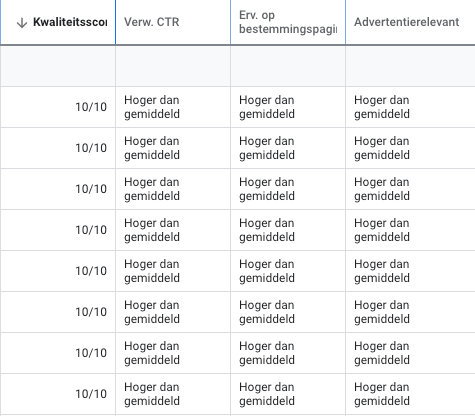Menu
Table of contents
But in addition to all those complex and advanced topics, sometimes it's important to go back to the basics. And today we'll cover part of that basics: quality score within Google Ads.
In this article, I explain exactly what the quality score (Quality Score) is, why it (still) matters and how to optimize it to improve your Google Ads results.
What is the quality score?
Google is always looking for the most relevant answer to the user's question (read: search query). Satisfied users come back and click on more ads. This is how Google makes its money.
To determine the quality and relevance of your ads, keywords and landing pages, Google created the quality score. This is a score of 1-10 that Google assigns to your ads.

Google rewards good advertisers by "discounting" their cost-per-click(CPC). The higher your quality score, the less you pay per click.
Thus Google creates a win-win-win situation for itself, its users and advertisers.
It is important to optimize the quality score so that you increase the return on investment of your ads.
Now that it's clear what the quality score means, I'll tell you what the score consists of.
The components of quality score at a glance
The quality score from three components:
- experience on the destination page
- ad relevance
- expected CTR(click-through rate)
These components are independently rated as "higher than average," "average," or "lower than average." These individual scores provide insight into where your optimization opportunities lie and therefore what you need to adjust specifically.
Incredibly useful, so let's dive deeper into those parts.
1. Experience on the destination page
This component indicates how well your landing page matches the user's search intent. In other words, whether the visitor finds what he is looking for.
So it is important to land users on the most relevant page possible. If someone searches for "White Nike Sneakers Size 42," make sure that this product can also be found on the landing page.
Sounds logical, but I still see it go wrong often enough. A good (actually bad) example of this is that in many cases advertisers land their potential customers on the home page.
This is because by doing so, you make it unnecessarily difficult for users to find what they are looking for. In addition, it signals to Google that your landing page does not fully match your user's search query and you will receive a lower score.
And that, in turn, results in poorer returns.
2. Advertising relevance
Ad relevance indicates how relevant your ad is to the user and the keyword they searched for. Here I'm going to use the same example again:
Suppose someone searches for "White Nike Sneakers Size 42," make sure you include that keyword in your ad text. This is because it shows that the ad matches the searcher's intent.
If you advertise on the above keyword, but then name "Red Adidas Shoes" in your ad, Google may give you a low quality score on ad relevance.
Yes, I repeat it again, but that can result in a poorer return on your Google Ads campaigns.
3. Expected CTR
We have arrived at the third component that determines your quality score. Expected CTR is a bit more complicated than destination page experience and ad relevance.
The expected CTR indicates how likely your ad is to be clicked. For this, Google takes into account how your keyword has performed historically.
In other words, how well or poorly you have done recently.
The expected CTR is different from the actual CTR because it is a prediction. Google cannot predict the future, but it comes pretty close.
How do you optimize quality score?
Now you know what quality score is, what it consists of and why it is important. Now I'm going to explain how to optimize each part of the score so you can reduce the cost per click and thus increase the return on investment of your campaigns.
When optimizing, you naturally look at the quality score of your keywords, but also at the score on the individual components (destination page experience, ad relevance and expected CTR).
You can then see where your optimization opportunities lie based on the score on experience on the landing page, ad relevance and expected CTR. If the score on any of these elements is "average" or "below average," you know this is where you can optimize.
If the score on a component is already "above average," you don't need to optimize anything. So always look at the components with average or below average scores.
1. Optimize experience on the landing page
Optimizing the experience on your landing page will not only ensure a higher quality score, but also a higher conversion rate.
And as an entrepreneur and marketer, that's something that makes your heart beat faster. To get you started, we've listed some concrete tips for optimizing your landing page:
- Make sure your content aligns well with the keyword
- Have the keyword reflected on your page (this is also good for the organic findability of the page)
- Test different pages. Is your bounce rate high? Then check the page, adjust it and possibly choose another, better page as the destination page
- Improve the loading speed of your page (this also has an impact on your organic findability)
- Make sure people find what they are looking for. If people expect to see an overview of, say, all your houseplants, show that too. Then don't start with a piece of SEO text.
In addition to these optimizations, Google itself provides some tips:
- Promote transparency and reliability on your website. Make use of reviews, share information openly, make sure your contact information is easy to find, state why you want to collect certain data, and properly identify advertisements.
- Make sure your navigation on mobile and desktop is easy to use, place the important content above the fold and don't bother people with unsolicited content.
2. Optimize ad relevance.
On to the next one: optimize ad delivery. Optimizing this is pretty straight forward and can be done mainly in the following three ways:
- Reflect your keyword in the ad text (preferably in the first title and first description line). Make sure the text is easy to read and not stuffed with keywords, which in turn penalizes Google with lower scores.
- Do you have multiple keywords in an ad group? Pull out the keyword with low ad relevance and put it in a separate ad group so you can optimize the ad text specifically for that keyword
- Add exclusion keywords to prevent your ad from displaying on specific searches. For example, are you advertising "White Nike Sneakers," but size 43 is out of stock? Then add "Size 43" as an exclusion keyword so that your ad does not display when someone searches for it
3. Optimize expected CTR
Optimizing expected CTR is a bit more complex.
This is because it is a prediction made by Google based on historical data. This figure shows how likely your ad is to be clicked and is influenced by multiple factors that cannot always be traced.
The score on expected CTR often rises along with the scores on experience on the landing page and ad relevance. So when optimizing, pay attention to the following:
- The overall quality of your ads and landing page (so pay close attention, to the tips I gave earlier)
- Add as many relevantad extensions as possible
- Add as many different ad types as possible (including Extended Text ads and Responsive Search ads)
Conclusion
I've now explained to you all about quality score and how to optimize it. Doing this will increase the relevance of your keywords, ads and landing pages. As a result of a high quality score, your cost per click will go down and you may start bringing in more conversions.
So your efficiency will improve many times over. And that's what we all do it for. Good luck!











Written by: Daniel Kuipers
Daniel is the founder of Online Marketing Agency. He constantly scours the Internet for the latest gadgets and tactics and blogs about them in understandable language. Well, sometimes.